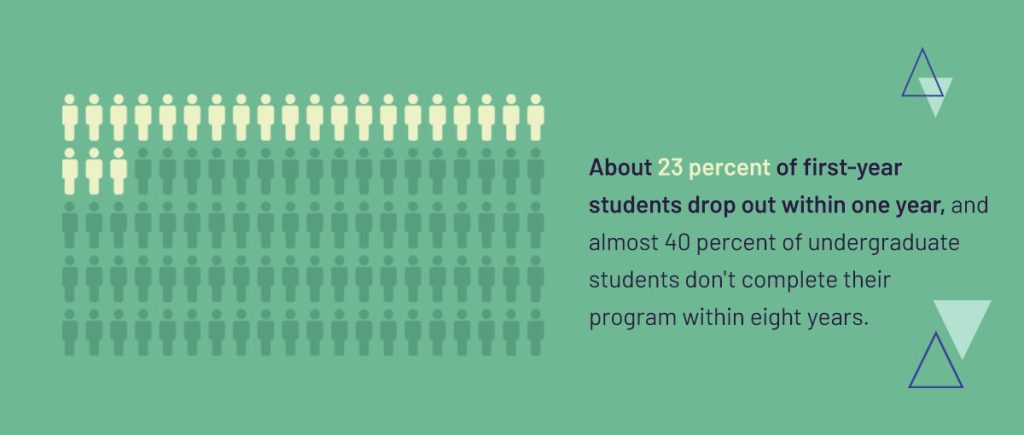



Community colleges play a vital role in preparing students for work without burdening them with high tuition costs found at four-year institutions. However, many students struggle to complete their programs. In a time where opportunity hinges on education, community colleges must offer students extra support to help them succeed.
Take a closer look at the importance of community colleges and what’s holding students back from success in this guide. You’ll also learn how to define, measure, and improve student access at your institution.
Students from various backgrounds attend community college to give themselves a better future. Many of them make the decision because community colleges offer:
Community colleges typically focus on providing career-oriented programs to prepare students to transfer to a four-year institution or enter the workforce. They provide program skills and academic knowledge that enable graduates to accept career positions or lay a foundation for their higher education.
The low cost of community college makes higher education more affordable for those with low-income families. After two years, graduates can obtain an associate’s degree that exemplifies their satisfactory work. An associate’s degree also enables them to transfer to other colleges or universities with higher education credits under their belts but without massive student debt.
Community colleges also cater to a broader pool of students. Although students of any age, gender, race, and background can attend four-year institutions, community colleges are an excellent guided pathway for those in different stages of life. Military veterans, single parents, immigrants, and nontraditional students are more likely to see community colleges meeting their educational needs.
Education is even more important today for succeeding in the job market. College education gives students the training they need to join their desired careers and make a positive impact on their communities. With new skills, students have a higher chance of finding a job and feeling greater career satisfaction. They receive higher pay, too.
In 2023, graduates with an associate’s degree made just over $159 more per week than those with a high school diploma, and bachelor’s degree holders made over $597 more than those without higher education. With such impressive benefits, it’s no wonder there is a growing focus on college completion.

However, despite the economic and career growth graduates can see, many institutions face low retention numbers from students dropping out or transferring to another institution. About 23 percent of first-year students drop out within one year, and almost 40 percent of undergraduate students don’t complete their program within eight years. Lower retention rates can impact an institution’s ability to attract students and receive funding.
Obtaining a college degree is challenging for many students as they face new obstacles. Various factors can inhibit student success, both on and off campus. Addressing these concerns will take time but can positively impact your students and institution in the long run.
Common barriers students face include:
Student success is a measure of positive student outcomes. It often refers to graduation or program completion, as this is the main goal for both students and institutions. However, there are many other ways to define student success in community college. What one institution considers success may look different to another. How you define student success depends on your institution’s goals and student needs.
Metrics that offer a better reflection of student success include:
After defining student success, you can begin to measure it at your institution. Measuring student success involves collecting and analyzing data so you can see how well students achieve positive outcomes. You can also identify any barriers that impede success and work to eliminate them. The more information you have to work with, the better equipped you’ll be to drive change at your institution.
You can measure student success through:
Once you’ve identified areas that are potentially holding students back from succeeding, you can decide how to best support them. If you’re not sure how, try one of the following approaches:
Student success courses help students hone personal and academic skills required for degree completion. These courses can better prepare students for the educational environment and increase the likelihood of graduation. Students not equipped for the rigor of collegiate-level classes can benefit from an introductory course that will familiarize them with the institution’s expectations and resources. This way, when they discover new barriers, they may be better equipped to overcome them.
Registration can be confusing for students, especially if they have an unclear graduation path. Students often need clarification about which courses they need to take to meet completion requirements. They may also need help understanding the importance of taking a prerequisite course or an introductory-level class that provides a foundation for other learning materials. Without guidance, students take courses they don’t need and may struggle to complete their studies.
You can combat this by providing registration assistance. Developing a registration office can give students somewhere to go when they need help building their schedules. The registration assistance process also identifies risk indicators such as holds, late fees, midterm grades, residential status, GPA, and undecided majors. When you pinpoint these indicators, you can take action to bring students back on track at a pivotal time in their education, ensuring that they complete their programs.
A student’s first year on campus is the most critical for their academic journey. During this time, students refine their ideas about higher education, face new challenges, meet new groups of peers and friends, and leave behind their high school and family support systems. Their experience in this first year sets the tone for the rest of their time at your institution.
Students who arrive at your institution feeling support and belonging are more likely to succeed. Offering first-year seminar classes, developing clubs, and fostering well-being and belonging on campus can help these students better face the challenges ahead. Encouraging students to make connections can also help them focus on their academics while having more positive feelings about your institution.
Academic planning is the process of guiding students through their education journey, giving them a roadmap to success. It’s more encompassing than tutoring or writing center services, although these could also boost student success. Academic planning involves developing clear program roadmaps, offering personalized advising, and instructing students on the planning process.
Through academic planning, students receive tools that help them:
Early assessments can be a great way to monitor student progress. When you administer self-assessments, surveys, and evaluations early in a student’s academic career, you can better gauge the support students need. Additionally, you can administer cumulative assessments throughout the year to gauge whether students are falling behind. Cumulative assessments cover current and previous content to better evaluate student comprehension and learning.
Mentors serve as a helping hand, offering valuable academic, professional, and personal advice. Your students could benefit from a mentorship program that connects them with professionals who currently work or have experience in their desired career field or industry. Faculty members, alumni, and senior students can serve as excellent mentors for new students.
As new students navigate your institution, they can turn to their trusted mentor when they need guidance. Along with allowing for better access to industry secrets, campus resources, and a support system, many mentor relationships become lifelong friendships. Mentorship success coaching can motivate students to perform better and enable you to create more holistic experiences for every student.

At Watermark, we’re dedicated to equipping higher education institutions with unique solutions that boost student success and prepare learners for a lifetime of productivity and learning.
Watermark Student Success & Engagement is an all-encompassing software solution your institution can use to monitor and track student progress and identify pain points in your curriculum, campus culture, and experiences. With our software, you can create holistic guided pathways for each student and take advantage of intuitive, advanced reporting. You can easily identify at-risk students and connect with them during their critical periods to bring them back on track.
With Watermark Course Evaluations & Surveys, you can also measure student success in the classroom. The software makes it easy to gather and use your student’s direct feedback to uncover new ways to design programs and structure curricula to meet their needs.
Request a demo of Watermark solutions to bring innovation to your institution and better define, measure, and improve student success on campus.






























































































































































































































































































































































































Submit this form to schedule a meeting with one of our reps to learn more about our solutions. If you need customer support instead, click here.